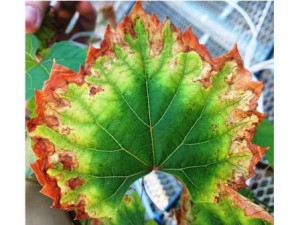Enzyme Discovery Sheds Light On Pierce’s Disease Damage

Grapevine leaf exhibiting Pierce’s disease symptoms.
Photo: Aaron Jacobson, UC-Davis
Pierce’s disease costs the California grape and wine industry more than $100 million each year. But, a new discovery could be a game changer in how the disease is treated.
Plant scientists at the University of California, Davis have discovered an enzyme they think could be responsible for the bacterial infection that causes Pierce’s disease.
Professor of Plant Sciences Abhaya Dandekar, who is senior author of the new study, says the newly discovered enzyme, called LesA, could explain some discrepancies in past theories about the spread of Pierce’s disease symptoms.
For example, the consensus has been that the leaf scorching symptoms are a result of the Xyllela fastidiosa bacteria clogging the xylem and limiting the transport of water. The leaves tend to scorch starting at the edges before spreading down toward the center of the leaf until it’s completely scorched and falls off.
However, high levels of Xyllela fastidiosa in the leaves does not always correlate with severe leaf symptoms. In other infected plants, the leaves are badly scorched but the xylem is hardly blocked.
Dandekar and his team began to investigate if something other than a clogged xylem could be responsible for the leaf scorch. Using a newer technology called proteomics, they analyzed the bacteria’s collection of enzymes and proteins and discovered that a particular protein – the LesA enzyme – was abundant in infected leaves. “We could see that [the enzyme] was present in higher concentrations at the edges of the leaf, and the concentration decreased as you came to the center of the leaf,” Dandekar says.
The researchers were able to knock out the activity of the enzyme and its ability to scorch. “Given that, we figured out that this protein is a really important part of the disease,” Dandekar says.
It was determined that the enzyme can move through cell membranes and equip the bacteria to invade the vines, causing the leaf scorch seen in Pierce’s disease.
The goal now is to look at how controlling the LesA enzyme can help inhibit the disease. “It gives you a way to study and dissect the disease that we really didn’t have before,” he says. “It gives us a better understanding of the disease process currently, and then provides us maybe more options on how to control this disease.”
Currently, the only the way Pierce’s disease is controlled is by spray applications, which target the insects that transmit the disease. “We virtually do nothing about the bacteria that’s quite endemic,” Dandekar adds.
Understanding how the bacteria persist would provide new tools to fight the disease. “It becomes a tool to dissect the process and also validate how treatments are working,” Dandekar says. “Treatments could be directed at the bacteria.”
The research for the study was conducted by two of Dandekar’s graduate students, Rafael Nascimiento and Hossein Gouran.









